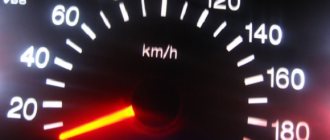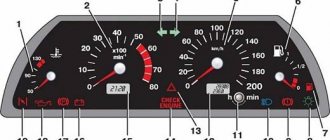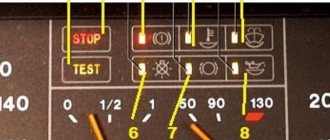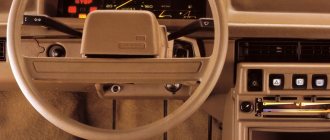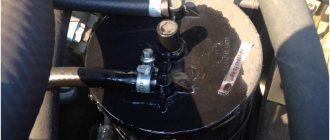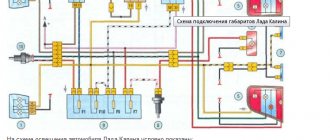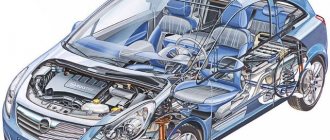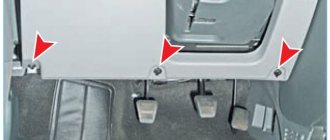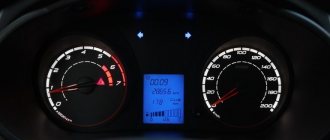Why does the exclamation mark light up on the instrument panel?
At the moment when the car brakes, the brake cylinders are pushed forward as much as possible, thereby acting on the pads.
At this time, the cylinders are filled with the required amount of brake fluid in the system, and its level in the reservoir drops. It is for this reason that a similar exclamation mark lights up on the instrument panel, informing the driver about the minimum level of brake fluid in the reservoir, and accordingly in the system as a whole. If such an indication occurs, first of all we check the sensor itself, which is located in the brake fluid reservoir. It is a float that actively interacts with the brake fluid.
Why is the exclamation mark on the instrument panel of the VAZ-2112, what should I do?
Car : VAZ-2112. Asks : Sergey Smirnov. The essence of the question : An exclamation mark lit up on the instrument panel of the VAZ-2112, I don’t understand why?
Good afternoon I sometimes get an exclamation mark in a circle on my dashboard, most often this happens when braking! Please tell me what could be the reason and how to solve it?
Why does the exclamation mark (!) light up on the instrument panel?
At the moment when the car brakes, the brake cylinders are pushed forward as much as possible, thereby acting on the pads. At this time, the cylinders are filled with the required amount of brake fluid in the system, and its level in the reservoir drops. It is for this reason that a similar exclamation mark lights up on the instrument panel, informing the driver about the minimum level of brake fluid in the reservoir, and accordingly in the system as a whole.
Video with an overview of all warning lamps on the VAZ-2112
Reasons for appearance
If such an indication occurs, first of all we check the sensor itself , which is located in the brake fluid reservoir. It is a float that actively interacts with the brake fluid.
When the float is dismantled, it must be put away on a rag.
In order to check its serviceability, it is necessary, with the engine running, remove it from the tank body and manually change the position of the float. If the indication on the instrument panel does not disappear and does not react in any way depending on the influence on it, then the sensor is faulty and needs to be replaced.
However, if the sensor is working properly, there may be a brake fluid leak.
Where might brake fluid leak?
It is very easy to find out whether the required level of brake fluid is in the system, since it can be seen visually through the brake fluid reservoir. Its level should always be closer to o , and if it is significantly less, or its level has dropped, then a leak is possible.
Brake cylinder
The front brake cylinder is leaking
First of all, inspect the brake cylinders on all wheels for leaks.
As a rule, leaks most often occur on the rear drums due to their excessive overheating. It is not difficult to notice a leak on the cylinders, since in the case of the front cylinder, the leaks will be noticeable on the caliper, and on the rear, it can drip directly from the drum. Problems with these elements usually arise during the cold season.
How to check the brake fluid sensor
In order to check its serviceability, it is necessary, with the engine running, remove it from the tank body and manually change the position of the float. If the indication on the instrument panel does not disappear and does not react in any way depending on the influence on it, then the sensor is faulty and needs to be replaced. However, if the sensor is working properly, there may be a brake fluid leak.
Where might the brake fluid leak?
It is very easy to find out whether the required level of brake fluid is in the system, since it can be seen visually through the brake fluid reservoir. Its level should always be closer to o, and if it is significantly less, or its level has dropped, then a leak is possible.
First of all, inspect the brake cylinders on all wheels for leaks. As a rule, leaks most often occur on the rear drums due to their excessive overheating. It is not difficult to notice a leak on the cylinders, since in the case of the front cylinder, the leaks will be noticeable on the caliper, and on the rear, it can drip directly from the drum. Problems with these elements usually arise during the cold season.
Master brake cylinder
Main cylinder with reservoir: 1 – main cylinder body; 2 – low pressure sealing ring; 3 – drive piston of the “left front-right rear brake” circuit; 4 – spacer ring; 5 – high pressure sealing ring; 6 – pressure spring of the sealing ring; 7 – spring plate; 8 – piston return spring; 9 – washer; 10 – locking screw; 11 – drive piston of the “right front-left rear brake” circuit; 12 – connecting sleeve; 13 – tank; 14 – brake fluid emergency level sensor; A - gap
- When inspecting the brake master cylinder, inspect its external condition for visible leaks.
- The main place where a rupture can occur is the rubber seal located closest to the vacuum booster.
- If a leak occurs, brake fluid will drip onto the gearbox housing and then onto the CV joint on the left side. This is easy to notice, and only then proceed to replace it.
- If you find any of the above elements to be faulty, it must be replaced immediately. Since the operation of the car with such malfunctions is impossible.
- After the brake system element has been replaced, be sure to bleed the brakes, as air will accumulate in the system during the work.
Please note that replacing brake fluid is also necessary because, over time, it accumulates water particles from the air and becomes less effective.
If you find an error, please select a piece of text and press Ctrl+Enter.
Reasons for the appearance of the indication
At the moment of braking, the brake cylinders make maximum forward movement, acting on the pads. The cylinders themselves are filled with liquid, which leads to a drop in its level in the tank. A message with an exclamation mark indicates exactly this - the liquid level has dropped to a minimum value.
In addition to the above reasons, the following situations cause the message to appear:
- Brake fluid level sensor malfunction. In order to ensure its serviceability, it is necessary to remove the float from the tank with the engine running and change its position in the container. If the display on the panel has not changed, then this is the reason for its occurrence.
- Brake fluid leak. Visual inspection of the cylinders on the wheels for traces of liquid. Most often, leaks occur on the rear drums.
- Broken or cracked brake hose. Upon inspection, it is not difficult to find such damage. Most often, malfunctions occur in bending areas.
- Damage to the master brake cylinder. The most common place where a rupture occurs is the rubber seal near the vacuum booster. A visual inspection shows that fluid is leaking onto the gearbox housing and the shield, located on the left side.
Important! If any of the above malfunctions occur, you must immediately contact a repair shop, since operating a vehicle with such damage is impossible and unsafe. If there is no brake fluid, driving is prohibited!
The exclamation mark is on: why, what to do?
Many car owners experience situations when an exclamation mark lights up on the instrument panel. On different car models it can be of different shapes and colors - yellow, red, white, in a square, in a circle, in a triangle. But in any case, it means that the car needs to be checked.
It must be said that such a check does not always require a visit to a car service center. In most cases, you can understand why the exclamation mark is on and what is happening to the car on your own.
From this article you will learn:
VAZ 21102. Does not start, exclamation mark is on
July 29, 2014, 22:55 #1
Good day.
The problem is already in its second day.
While driving to the house, the car made a soft whistling sound and the wax light came on. sign. This did not affect the ride in any way. I drove up to the house, stopped, put the car in reverse, and parked. I decided to check what would happen if I turned off the engine and turned it on again - would the wax disappear? sign.
The car did not start and when turning the key to position II (ignition), the wax sign began to light up. At the same time, no sounds were heard from under the hood. Even the starter doesn't turn over.
I checked the handbrake, climbed under the hood, and added brake fluid. Same effect. I removed the terminal from the battery, waited, connected it - the same effect. I removed the brake fluid reservoir sensor, same effect.
I removed the terminal and left it overnight. In the morning, the same way, when turning to the second position, the car does not make a sound, the wax lights up. sign, zero emotions.
I decided to charge the battery. The battery was old, but seemed to breathe life. Charged the battery. All lights, windows, wipers, etc. work fine. The car won't start.
What could be the problem.
Exclamation icon sign in brackets and a circle - according to the manual, this is a problem with the brake fluid level. But that’s no reason not to start the engine, right?
July 30, 2014, 00:13 #2
AlexV, July 29, 2014, 10:55 pm, #1
Good day.
The problem is already in its second day.
While driving to the house, the car made a soft whistling sound and the wax light came on. sign. This did not affect the ride in any way. I drove up to the house, stopped, put the car in reverse, and parked. I decided to check what would happen if I turned off the engine and turned it on again - would the wax disappear? sign.
The car did not start and when turning the key to position II (ignition), the wax sign began to light up. At the same time, no sounds were heard from under the hood. Even the starter doesn't turn over.
I checked the handbrake, climbed under the hood, and added brake fluid. Same effect. I removed the terminal from the battery, waited, connected it - the same effect. I removed the brake fluid reservoir sensor, same effect.
I removed the terminal and left it overnight. In the morning, the same way, when turning to the second position, the car does not make a sound, the wax lights up. sign, zero emotions.
I decided to charge the battery. The battery was old, but seemed to breathe life. Charged the battery. All lights, windows, wipers, etc. work fine. The car won't start.
What could be the problem.
Exclamation icon sign in brackets and a circle - according to the manual, this is a problem with the brake fluid level. But that’s no reason not to start the engine, right?
March 18, 2015, 11:42 #3
Good day.
The problem is already in its second day.
While driving to the house, the car made a soft whistling sound and the wax light came on. sign. This did not affect the ride in any way. I drove up to the house, stopped, put the car in reverse, and parked. I decided to check what would happen if I turned off the engine and turned it on again - would the wax disappear? sign.
The car did not start and when turning the key to position II (ignition), the wax sign began to light up. At the same time, no sounds were heard from under the hood. Even the starter doesn't turn over.
I checked the handbrake, climbed under the hood, and added brake fluid. Same effect. I removed the terminal from the battery, waited, connected it - the same effect. I removed the brake fluid reservoir sensor, same effect.
I removed the terminal and left it overnight. In the morning, the same way, when turning to the second position, the car does not make a sound, the wax lights up. sign, zero emotions.
I decided to charge the battery. The battery was old, but seemed to breathe life. Charged the battery. All lights, windows, wipers, etc. work fine. The car won't start.
What could be the problem.
Exclamation icon sign in brackets and a circle - according to the manual, this is a problem with the brake fluid level. But that’s no reason not to start the engine, right?
UAZ Patriot 3163
March 21, 2015, 19:21 #5
Sorry I pressed the wrong button
check all fuses. And all starter relays are small black boxes, they usually come with a fuse box
UAZ Patriot 3163
March 21, 2015, 19:23 #6
UAZ Patriot 3163
March 21, 2015, 19:28 #7
It wouldn't be bad to try to start it with a cable! If it starts, it means the starter has definitely failed, either the starter fuse (I had this on my Patrick) or the retractor switch has decided to push the bendex onto the flywheel crown, resulting in a squeal or noise from under the hood and the starter is damaged. but for starters it’s not a bad idea to look at the simplest things!
Sverdlovsk region. Kamensk-U
Daewoo Matiz 0.8 Mx
March 22, 2015, 07:19 #8
Zhenk A042TM, March 21, 2015, 19:21, #5
Sorry I pressed the wrong button
check all fuses. And all starter relays are small black boxes, they usually come with a fuse box
The exclamation mark itself tells you that there is no ground on the parking brake lever (this sign goes out when the lever is lowered all the way down, i.e. “-“ is supplied from the car body, and if there is none, then you need to look for ground on the gas pump, gas tank) .
UAZ Patriot 3163
March 31, 2015, 12:44 #9
It's strange that yours is on fire. this exclamation mark.
3 October 2015, 19:32 #10
The Mazda 3 car, manufactured in 2009, will not start, there is an exclamation mark on the panel, under it there is a sign - defective, could this be the reason?
How the icons on the dashboard work
To understand what is happening with the car, first the car owner needs to understand how the icons on the instrument panel (pictograms) work and how they signal malfunctions.
On different cars, many different icons may be displayed on the instrument panel, informing the driver about the functionality of a particular system. This includes a braking system, an anti-lock braking system, a motion stabilization system, a battery charging system, an airbag system, a tire pressure monitoring system, and auxiliary systems such as cruise control.
Every time you start the engine, all the icons on the instrument panel should light up and go out after a second or two - thereby showing that the bulbs in the icons have not burned out, the icons themselves are operational, and the systems that are monitoring are operational. If, when starting the engine, all the icons go out, but one or two remain on, it means that the system they are monitoring requires checking.
Icons on the Priora dashboard
Please describe the icons on the Lada Priora instrument panel.
- Tachometer . Crankshaft rotation speed. The needle must not go into the red zone. The red zone is dangerous for the engine.
- Brake force distributor malfunction lamp . Lights up red for a few seconds when the ignition is turned on. If the lamp lights up in other cases, this may indicate a system malfunction.
- Battery charge lamp. Lights up red when the ignition is turned on and goes out immediately after the engine starts. If it lights up even after starting the engine, this indicates that the battery charge has expired/the battery is faulty.
- Left turn indicator. Flashes when the turn signal is on, also flashes when the hazard lights are on.
- Speedometer. Shows the speed of the car.
- Emergency oil pressure lamp. Lights up red when the ignition is turned on and goes out immediately after starting the engine. If the lamp is lit in any other case, this indicates low pressure in the system. Operating the car in this case is dangerous for the engine.
- Right turn indicator. Flashes when the right turn signal or hazard warning lights are on.
- Parking brake. Lights up red when the handbrake is applied.
- Coolant temperature indicator. Under normal conditions, the needle is located in the middle of the scale. Engine operating temperature is 90 degrees and above to the red zone. The arrow should not fall into the red zone, which indicates engine overheating. In this case, it is prohibited to further operate the car. You can continue using the car as soon as the needle drops to normal values.
- Fuel level indicator in the gas tank. P shows the fuel level. If there is no gasoline, the fuel pump may fail.
- Fuel reserve lamp. Lights up when there is less than 10 liters of fuel left in the tank. Also, a beep sounds.
- Button for switching display modes and resetting the daily mileage counter. To reset the daily mileage, hold the button pressed for 3 seconds.
- Alarm. Flashes along with turns when the emergency lights are turned on.
- EUR malfunction icon. Lights up yellow when the ignition is turned on for a few seconds and goes off. In other cases, if the lamp is lit, it indicates a malfunction of the EUR.
- High beam headlight lamp.
- Lamp for turning on external lighting. Lights up when the headlights and low beam are turned on.
- Airbag system malfunction icon. Lights up yellow for a few seconds when the ignition is turned on and goes off. If the lamp burns in any other cases, it may indicate a malfunction in the airbag system.
- Immobilizer icon. Lights up or flashes yellow and displays the status of the immobilizer system and the vehicle's security mode. If the system is in order and the engine is allowed to start, when the ignition is turned on, the lamp flashes 1 time and goes out.
- LCD display of on-board computer. Displays information from the on-board computer, as well as daily and total mileage.
- Unfastened seat belt. Lights up when the ignition is turned on if the driver's seat belt is not fastened.
- Brake system emergency lamp. Lights up red when the ignition is turned on for a few seconds and goes out. The lamp also lights up when the brake fluid level is insufficient and when a malfunction occurs in the service brake system.
- Passenger airbag deactivation icon (optional). Lights up when the ignition is turned on.
- ABS fault icon (optional). To check, the lamp lights up when the ignition is turned on and goes out after a few seconds or after the engine starts. If the lamp is lit, there is a malfunction in the ABS system. However, the performance of the braking system is not affected.
- Engine fault lamp. Check Engine. To check, it lights up when the ignition is turned on and goes out after the engine starts. In other cases, the lamp is lit indicating an engine malfunction. It is not recommended to operate the car in this case.
What does the exclamation mark mean?
In the vast majority of cars, the "exclamation mark" icon on the instrument panel indicates problems with the car's braking system. Often it lights up in conjunction with an icon indicating the operation of the ABS system and the vehicle stabilization system (if equipped). The appearance of these icons on the driver's instrument panel means that there may be a problem with the brake system and the brakes cannot be trusted.
A malfunction in the car’s braking system is included in the list of faults with which the operation of the car is prohibited by the “Road Rules”. In addition, the driver himself should understand that driving with possibly faulty brakes can lead to the most dire consequences.
If the icon lights up immediately after starting the engine, it is better for the driver to postpone the trip and check the car’s braking system. If the icon lights up while driving, the driver needs to urgently stop and check the brake system.
Note : The "exclamation mark" icon located "inside the tire" indicates low pressure in the vehicle's tires. If it appears on the dashboard, you need to check the tire pressure at the nearest tire shop.
Reasons for the appearance of the icon
The most common cause of a car's brake system malfunction is a drop in brake fluid level. For this reason, on some cars the “exclamation mark” icon may “blink”, depending on driving conditions (the brake fluid splashes in the reservoir, causing its level to become lower or higher).
The fluid level may drop for several reasons, for example: due to a fluid leak, due to severe wear of the brake pads, or due to evaporation during long-term operation without replacement (fluid replacement according to the regulations must be done at least once every two of the year).
Another reason for the appearance of the icon may be a significant decrease in pressure in the brake system, which is created by the vacuum brake booster. In this case, diagnostics of the vacuum amplifier is necessary.
The icon on the instrument panel may also light up if the fault warning system itself is damaged. That is, if the brake system sensor stops working, it informs the driver about it.
The reason for the appearance of the “exclamation mark” icon can also be a malfunction of the hand brake - the parking brake system of the car. For example, the handbrake position sensor may not work correctly, or the handbrake itself may not be completely turned off.
It is worth saying that many modern cars have a built-in computer with extensive capabilities, among which, in addition to setting up vehicle functions and controlling the multimedia system, there is also an express diagnostics section, which displays information about the condition of the car. When any icon appears on the instrument panel, the driver would do well to look into this section, where you can learn about the problem in more detail.
What to do if the lamp comes on?
- The first thing you need to do is check the fuel fluid level. This is done simply and without any difficulties. Open the hood and look at the level, it should be between o and “MAX”. The level must be monitored constantly; for those who forget to do this, there is an exclamation mark. It lights up based on a signal from the sensor, which signals when the fuel level is below the permissible level.
By the way! There are often cases when the light comes on when driving over uneven surfaces and goes out as soon as the car drives onto a more or less level road. This happens precisely for the reason that the level of “brake fluid” is close to o and when the car is rocking, the sensor detects a low level and signals this to the instrument panel.
- If everything is in order with the brake fluid level, you need to check the fuel injection system, which is located in the brake fluid tank. I'll tell you how to do this now.
2.1. Turn on the ignition and make sure that the exclamation mark lamp comes on, that is, the indicator of insufficient fuel level. It should light up and go out if the level is normal and the sensor is working.
2.2. We turn off the power from the sensor and look at the lamp; if it goes out, most likely there is a problem with the sensor. Check the sensor, sometimes the problem is that the float fails and sinks to the bottom even though the fuel fluid level is fine.
2.3. If, after turning off the power from the sensor, the exclamation mark on the panel continues to light, most likely the problem is in the wiring, and the sensor itself is working. Perhaps the reason is a short circuit in the wiring, or something else, but one way or another the problem will be associated with a faulty wiring and a violation of its integrity.
If everything is fine with your fuel oil level sensor, but you want to check its operation, this is done quite simply
2.4. We press the rubber seal on the tank lid, so you lower the sensor float to the bottom, and in working sensors an exclamation mark on the panel lights up.
2.5. If the indicator does not light up, take a small piece of copper wire and turn off the power from the brake fluid level sensor. The prepared wire must be used to close the power contacts of the sensor, that is, the contacts on the wiring that is supplied to the sensor, and not the contacts of the sensor itself. With such a short circuit, a corresponding signal about low brake fluid level should appear on the panel. If this does not happen, most likely the sensor is working, and the problem is faulty wiring.
If the brake fluid level sensor is faulty, replace it; if the problem is in the float of this sensor, you can try to repair it; if the wiring is faulty, replace it or seek help from an experienced auto electrician.
What to do if the icon appears
The first thing the driver needs to do when the “exclamation mark” icon appears is to postpone his trip (or stop if the icon appears while driving).
Then you need to try to understand why the icon appeared. To do this you need:
- Go to the “car status information” section of the on-board computer (if there is one) and find there the reason for the appearance of the icon;
- Check the brake fluid level in the reservoir under the hood and add fluid if necessary;
- Check the connector of the brake fluid level sensor (remove and clean), it happens that dirt gets under the connector casing or brake fluid fills it;
- Check the position of the handbrake and its limit switch, tighten and release the handbrake several times;
- Check the condition of the brake pads (if the wheels allow this); excessive wear on the pads may be the cause of a low brake fluid level;
- Check the operation of the brakes by pressing the pedal (if it is very soft or very tight, it is better not to drive the car again until the problem is eliminated);
- If you can’t independently determine the reason for the appearance of the “exclamation mark” icon, it is better to call a tow truck and take the car to a car service center, or try to find a good on-call diagnostician;
- If the nearest car service center is far away and there are no diagnostic specialists, you can try to read the errors yourself through the car’s diagnostic connector, via a special Bluetooth or Wi-fi adapter. For example, the ELM-327 adapter is very convenient and popular, which can be ordered with home delivery;
The exclamation mark on the instrument panel lights up. What to do if the lamp (!) comes on
Hi all! Today I want to raise a rather current topic that, judging by the questions on the forums and the number of requests in search engines, worries a large number of people. I want to talk about a phenomenon where when you press the brake pedal, an exclamation mark on the dashboard lights up.
I will try to give a comprehensive answer to this question and explain why this happens and what kind of damage may be involved. Go!
Let me start, perhaps, with the fact that if a lamp (!) lights up on the panel, it means something is wrong with the brake system. As a rule, this indicator signals a low level of brake fluid (BF) in the system. As you can imagine, faulty brakes are no joke and the problem needs to be addressed. I’ll say more, if anyone doesn’t know, OPERATING A CAR WITH A BURNING INDICATOR (!) IS PROHIBITED! Since you don’t know what’s wrong and what caused this error to appear on the dashboard.
In what cases does the exclamation mark light up?
- Low level of TJ.
- The problem is poor contact. As a rule, we are talking about the sensor connector on the brake master cylinder (MBC).
- Break. Wiring problem or open circuit.
- The brake fluid level sensor (BLL) is faulty.
- Something is wrong with the instrument panel.
What to do if the lamp comes on?
- The first thing you need to do is check the fuel fluid level. This is done simply and without any difficulties. Open the hood and look at the level, it should be between o and “MAX”. The level must be monitored constantly; for those who forget to do this, there is an exclamation mark. It lights up based on a signal from the sensor, which signals when the fuel level is below the permissible level.
By the way! There are often cases when the light comes on when driving over uneven surfaces and goes out as soon as the car drives onto a more or less level road. This happens precisely for the reason that the level of “brake fluid” is close to o and when the car is rocking, the sensor detects a low level and signals this to the instrument panel.
- If everything is in order with the brake fluid level, you need to check the fuel injection system, which is located in the brake fluid tank. I'll tell you how to do this now.
2.1. Turn on the ignition and make sure that the exclamation mark lamp comes on, that is, the indicator of insufficient fuel level. It should light up and go out if the level is normal and the sensor is working.
2.2. We turn off the power from the sensor and look at the lamp; if it goes out, most likely there is a problem with the sensor. Check the sensor, sometimes the problem is that the float fails and sinks to the bottom even though the fuel fluid level is fine.
2.3. If, after turning off the power from the sensor, the exclamation mark on the panel continues to light, most likely the problem is in the wiring, and the sensor itself is working. Perhaps the reason is a short circuit in the wiring, or something else, but one way or another the problem will be associated with a faulty wiring and a violation of its integrity.
If everything is fine with your fuel oil level sensor, but you want to check its operation, this is done quite simply
2.4. We press the rubber seal on the tank lid, so you lower the sensor float to the bottom, and in working sensors an exclamation mark on the panel lights up.
2.5. If the indicator does not light up, take a small piece of copper wire and turn off the power from the brake fluid level sensor. The prepared wire must be used to close the power contacts of the sensor, that is, the contacts on the wiring that is supplied to the sensor, and not the contacts of the sensor itself. With such a short circuit, a corresponding signal about low brake fluid level should appear on the panel. If this does not happen, most likely the sensor is working, and the problem is faulty wiring.
If two icons are lit, “exclamation mark” and ABS
This often happens when two icons light up on the instrument panel at once, for example, an “exclamation mark” and an ABS icon (or a stabilization system icon in the form of a “car on a crooked path”).
Since the car’s braking system is often very closely connected with the ABS system (Anti-lock Braking System) and the motion stabilization system, if a malfunction occurs in one of these systems, the second may also stop working and/or be forced to turn off on-board computer. Therefore, if two icons appear on the instrument panel at once, you will have to look for a fault in two systems at once.
A ringing voice flies into the distance
VAZ 2112 2001, please explain how the low brake fluid level lamp (exclamation mark on the instrument panel) is connected to the starter and ignition switch.
I cleaned all the wires and contacts, it didn’t help, I can start it with a screwdriver... What nonsense, red yellow, handbrake, sorcerer asks to go somewhere, this is a VAZ 2110. This icon means that the brake fluid level is low or there is something wrong with the sensor itself. The symbols on the instrument panels on all VAZs are almost the same, just the location is different.
There were similar things - it came on when braking, went out periodically... in short, it didn’t stay on all the time. Rashit is right! This is what I do on mine - the low brake warning light starts to turn on periodically - I change the pads. The liquid rises to the maximum level.
It also happens that brake hoses “swell” due to age, and the volume of brake fluid “leakage” also moves further away from the normal level. Before starting the engine, it lights up constantly to check the health of the light bulb, if I'm not mistaken. A friend’s Check Engine light was on on a VAZ 2112 1.6 16 valve. it was on and off.
The lock is in two positions only? jammed? Maybe there is air left and when you press the brakes the level goes away. 2110 (or rather, maybe he only knows the VAZ 2110, but very poorly). If it refuses to light up when you crank the starter and the handbrake is raised, then this is a jamb. If this is the case, then most likely the problem is in the “crooked” installation of the alarm with auto-start.
In this case, you need to check the light bulb itself (burnt out), or the handbrake lever
We need to figure out what we are talking about. It seems like we are talking about different things: 1) The “low brake” light has nothing to do with the position of the handbrake. Many car enthusiasts are faced with this seemingly simple question.
1 — Coolant temperature, in degrees Celsius. 8 - Indicator lamp for turning on the dimensions. 13 - Hazard warning lamp - “hazard light”. 14 - Check Engine, often indicated by this icon - this means a malfunction in the engine, it is recommended to stop the engine.
This sign indicates insufficient brake fluid level. The ignition switch assembly looks like the key has three positions: 1) All electrics are on, 2) that is, just turned off, and 3) turning on the starter. If the handbrake is tightened, the light ((P)) is on. In general, the exclamation mark is the brake fluid or the brake pad wear sensor, some do not turn it off.
Not everything is so simple with red indicators on the instrument panel: it is important to know their purpose
For those who do not know why this can happen, let us explain:
If the parking brake light comes on even though the handbrake is off, this may indicate a low brake fluid level or that the pads are worn out, if the latter are equipped with a wear indicator in more or less modern cars.
This will alert you to possible brake line leaks and the need to replace your brake pads before your brakes fail completely. Don't ignore this sign:
Or this indicator:
It informs about the increased temperature of the engine coolant, that is, overheating. Not to be confused with the yellow sign on the same dashboard that shows the expansion tank. The latter indicates a low level of “cooling”.

